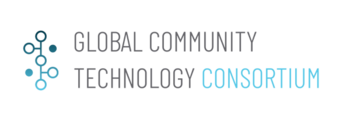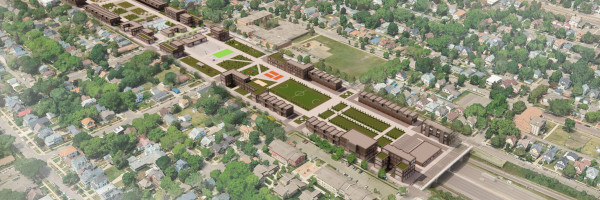Reconnect Rondo: Difference between revisions
No edit summary Tag: Reverted |
No edit summary Tag: Manual revert |
||
| Line 6: | Line 6: | ||
|municipalities=St. Paul MN | |municipalities=St. Paul MN | ||
|status=Launched | |status=Launched | ||
|website=https://reconnectrondo.com/vision/ | |website=https://reconnectrondo.com/vision/ | ||
|download=None | |download=None | ||
Revision as of 01:31, January 9, 2025
| Reconnect Rondo | |
|---|---|

| |
 Reconnect Rondo | |
| Team Organizations | Minnesota Governor Tim Walz Reconnect Rondo |
| Team Leaders | Tim Hunt |
| Participating Municipalities | St. Paul MN |
| Status | Launched |
| Document | None |
Description
The ReConnect Rondo project is a transformative initiative aimed at restoring and revitalizing the historic Rondo community in Saint Paul, Minnesota, which was devastated by the construction of Interstate 94 in the mid-20th century. At its core, the project envisions creating Minnesota’s first African American cultural enterprise district, anchored by a community land bridge that reconnects Rondo’s past vibrancy with a future of economic and social equity. This ambitious effort seeks to rectify historical wrongs, restore wealth and control to African American residents, and foster opportunities for businesses, housing, and leadership development within the community. Through collaborative partnerships with leaders, organizations, and policymakers, ReConnect Rondo is committed to ensuring equitable development, preventing gentrification, and creating a national model for restorative justice and sustainable community revitalization.
Challenges
The project faces significant challenges, including overcoming the lingering impacts of systemic inequities and historical wrongs that devastated the community. Securing the substantial financial and technical resources required for the multi-layer, multi-year initiative—such as constructing a land bridge and developing a cultural enterprise district—will demand strong advocacy, policy changes, and widespread support. Preventing gentrification and displacement of existing residents while fostering equitable development is a critical concern, requiring carefully crafted housing stabilization and anti-displacement policies. Coordinating the efforts of diverse stakeholders, including community members, policymakers, funders, and technical experts, poses logistical and organizational challenges. Additionally, addressing racial disparity gaps and ensuring the community’s leadership and control in decision-making processes will require sustained commitment and trust-building among all involved parties.
Solutions
The project addresses its challenges through a comprehensive, community-led approach that prioritizes equity, collaboration, and sustainability. By creating Minnesota’s first African American cultural enterprise district and reconnecting Rondo via a community land bridge, the project directly tackles the economic and social disparities caused by historical injustices. Robust anti-displacement policies, housing stabilization plans, and affordable housing initiatives aim to protect residents and prevent gentrification. Collaborative efforts among policymakers, community leaders, and stakeholders ensure that the development reflects the needs and priorities of the Rondo community. The project also promotes African American leadership and wealth-building opportunities, fostering business growth and career pathways while celebrating Rondo’s cultural heritage. Through these solutions, ReConnect Rondo provides a restorative model that addresses past wrongs and paves the way for a vibrant, equitable future.
Major Requirements
The project requires a combination of financial, technical, and organizational resources to achieve its vision. It needs significant funding to construct the community land bridge over Interstate 94 and develop infrastructure for the African American cultural enterprise district, including housing, businesses, and community spaces. Technical expertise from engineers, architects, and developers is essential for designing and executing the complex multi-year construction and development plans. Strong collaboration among policymakers, community leaders, equity organizations, and stakeholders is critical to align goals and ensure the community's leadership in decision-making. Additionally, comprehensive policies to prevent gentrification and displacement, along with actionable housing stabilization plans, must be established. Community engagement and advocacy will be vital to secure widespread support, influence policymakers, and sustain momentum for this transformative initiative.
Performance Targets
| Key Performance Indicators (KPIs) | Measurement Methods |
|---|---|
|
|
Standards, Replicability, Scalability, and Sustainability
The project will adhere to a number of urban planning and zoning regulations to guide the development of the land bridge and surrounding infrastructure, as well as environmental standards to mitigate the project's ecological impact and comply with state and federal laws. Housing standards are critical to ensure new units meet affordability, safety, and accessibility requirements. Anti-displacement and equitable development policies must align with best practices to protect residents and foster inclusivity. Construction standards, including engineering codes and safety protocols, will be essential for the design and execution of the land bridge. Additionally, community engagement standards emphasize transparency, inclusivity, and collaboration to reflect the needs and priorities of the Rondo community. Adherence to these standards will be vital to achieving the project’s restorative and equitable goals.
Cybersecurity and Privacy
The project will require centralized digital platform for community engagement, allowing residents and stakeholders to access updates, provide feedback, and participate in decision-making processes. Advanced Geographic Information Systems (GIS) and data visualization tools will be needed to map and analyze land use, transportation patterns, and demographic impacts. Secure cloud-based systems will be essential for managing project data, including designs, budgets, and schedules, while ensuring accessibility for collaborating organizations. Additionally, smart infrastructure technologies, such as sensors and IoT devices, can monitor environmental conditions, traffic, and construction progress. High-speed internet connectivity and digital tools for businesses within the cultural enterprise district will also be critical to fostering innovation and economic growth in the revitalized Rondo community.
Impacts
The project will address historical injustices and fostering a thriving, equitable future for the Rondo community. It aims to restore wealth and ownership for African American residents through affordable housing, business opportunities, and the establishment of Minnesota’s first African American cultural enterprise district. The project seeks to bridge racial disparity gaps by creating jobs, boosting local economic growth, and generating increased city revenue. It will also revitalize the community’s cultural heritage, positioning Rondo as a vibrant, heritage-rich neighborhood while defending it against gentrification and displacement. By connecting community members, policymakers, and organizations, the project aspires to build a national model for restorative justice and equitable development, with lasting social, economic, and cultural benefits for Rondo and beyond.
Demonstration/Deployment
These impacts will be demonstrated through measurable outcomes and visible transformations within the community. The completion of the land bridge and the establishment of new housing units will serve as tangible evidence of restored connectivity and revitalization. Economic growth will be reflected in the number of new jobs created, increased city revenue, and the growth of African American-owned businesses in the cultural enterprise district. Community stability and equity will be evident through the retention of existing residents, the implementation of anti-displacement policies, and active participation in leadership roles by African Americans. The preservation and promotion of Rondo’s cultural heritage will be showcased through events, public spaces, and community-led initiatives. These results, combined with increased collaboration among stakeholders, will highlight the project’s success in addressing historical wrongs and creating a vibrant, equitable future.